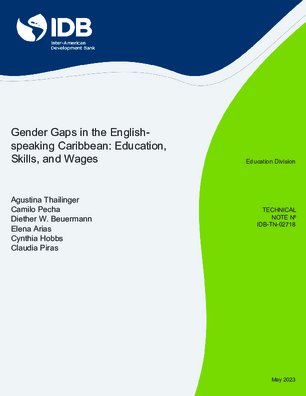Gender Gaps in the English-speaking Caribbean: Education, Skills, and Wages
Date
May 2023
This document contributes to the understanding of the reasons behind gender gaps in education and how they translate into labor market outcomes and trajectories in the English-speaking Caribbean. What are the main characteristics of these gaps? Are they observed through the entire life cycle? Do they grow over time? What factors can explain them? A detailed analysis of updated educational and labor market data for five countries of the English-speaking Caribbean - The Bahamas, Barbados, Guyana, Jamaica, and Trinidad and Tobago- complements previous studies by: (a) following the English-speaking Caribbean population from primary school to the labor market; (b) assessing the existence of gender gaps in education and in the labor market separately; and (c) analyzing the relationship between them and how one affects the other. The analysis confirms previously documented trends. Males tend to underachieve in terms of secondary and post-secondary studies when compared to females, as measured by enrollment, completion rates and learning outcomes. Our study analyses different factors that could be driving these gaps, such as gender roles, socialization processes for both girls and boys, classroom pedagogy in Caribbean schools, school curricula, and corporal punishment in households and schools. Despite females better results in education, their outcomes in the labor market are less favorable than those of males. Women show lower participation, and among labor market participants, they have higher unemployment rates and lower wages than men. For The Bahamas and Guyana, we document that wage gaps are primarily driven by non-observable characteristics unrelated to labor productivity. By contrast, in Barbados, Jamaica and Trinidad and Tobago, wage gaps seem to be mainly driven by labor market experience, occupational rank, and industrial sector. Reductions in gender-based sectoral and occupational segregation could significantly close the wage gaps observed in the latter countries. We recommend the continued collection of timely and accurate disaggregated data to inform policymaking and positively impact inclusive and sustainable development.




